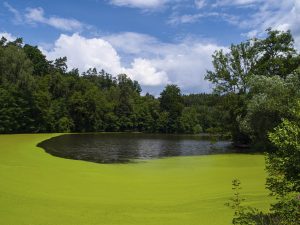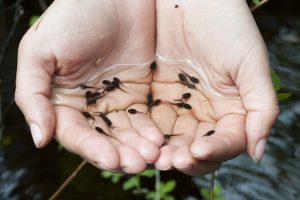2015 Water Institute Projects Study Vernal Pools, Water Treatment & Algae Blooms in Lakes
Each year the Maine Water Resources Research Institute (WRRI) funds projects that further knowledge of the State’s water resources. Three projects are being funded in 2015 that range in focus from the water flow puzzle of vernal pools to the deconstruction of an algae outbreak to a novel fix to a difficult drinking water problem.
The Water Institute is part of the Senator George J. Mitchell Center for Sustainability Solutions, which has a mission to produce knowledge and link it to actions that meet human needs while preserving the planet’s life-support systems.
See below for summaries of the new 2015 WRRI projects.
The Titanium Fix l Carpets of Algae in Vacationland l Its More than Just Rain
 Today, people eat blueberries for reasons other than taste. Health experts have preached their benefits for years, along with other fruits and vegetables rich in color. It’s because they contain antioxidants, which fight disease-causing free radicals in the body.
Today, people eat blueberries for reasons other than taste. Health experts have preached their benefits for years, along with other fruits and vegetables rich in color. It’s because they contain antioxidants, which fight disease-causing free radicals in the body.
Okay, take that common knowledge and reverse it. That’s how scientists working on a new WRRI project believe they can help solve a problem with drinking water coming from Lake Auburn.
See, the water, many complain, tastes and smells like fish and sometimes cucumber.
“In a water treatment system, unlike in the human body, free radicals can be really, really good because they attack the living cells of many toxic organics we are trying to get rid of,” said Aria Amirbahman, Professor of Civil and Environmental Engineering. “In this case, we hope they can help degrade the presence of these taste and odor causing compounds.”
Amirbahman and students will try to augment the Auburn Water District’s current UV light disinfection system with titanium coated glass plates. Though the UV system successfully eliminates many harmful compounds, it can’t degrade the algae-born chemicals that make the water taste bad in some cases. The problem stems from a growing algae bloom in Lake Auburn that is caused by the increased presence of phosphorous in the water.
When the plates are placed over UV lights, they activate a cascade of free radicals, which help destroy the taste and odor compounds as well as some viruses. If it works, the fix is very low cost, Amirbahman said, unlike the construction of a sophisticated filtration system that could cost millions.
“People equate taste and odor with water quality. That’s really important,” Amirbahman said. “Even if some of these compounds don’t make anyone sick, they’re not acceptable.” See more on this project…
Carpets of Algae in Vacationland
 For decades, most of the placid, tree-lined lakes of New England were glass clear. Idyllic spots such as the Belgrade Lakes drew visitors in droves. Those who could afford them built shoreline houses with lush lawns sloping to the water line. But in recent years, algae bloom has coated the water during parts of the summer – a factor that is both unsightly and potentially harmful to humans.
For decades, most of the placid, tree-lined lakes of New England were glass clear. Idyllic spots such as the Belgrade Lakes drew visitors in droves. Those who could afford them built shoreline houses with lush lawns sloping to the water line. But in recent years, algae bloom has coated the water during parts of the summer – a factor that is both unsightly and potentially harmful to humans.
Several causes may be at work. Paleolithic analysis shows blue-green algae bloom has occurred from time to time over the eons, scientists note. But fertilizer runoff and increased erosion from accelerated shoreline development may also contribute to the phosphorous sediment so essential to the algae growth. Most importantly, the blue-green algae mucking up the New England lakes may produce toxins that can affect humans’ skin, livers and brains at when present at high levels
So, how big is the problem? No one really knows yet.
A group of scientists from Colby College and the Bigelow Laboratory for Ocean Science have begun work on a grant from WRRI. The team will be gathering data on blue-green algae blooms in the Belgrade lakes this summer.
“The algae form a kind of gelatinous scum. It’s definitely something people see and are becoming more aware of as time goes on,” said Denise Bruesewitz, Assistant Professor of Environmental Studies and principal investigator on the WRRI study. “We’re really just starting to see this happening more in Maine. There’s a lot to learn.”
The technical name for the green-colored bloom is Gloeotrichia echinulata. It is actually a form of cyanobacteria and known to be very adaptable to different environments. Gloeotrichia form big colonies that overwinter on the bottom of lakes, possibly taking advantage phosphorous stored in the sediment. When they are well developed, algae float to the surface, where they multiply their colonies in the light environment. Fuzzy green carpets and ball-like globs become visible in late summer.
Over the next few months, Colby undergraduates will gather weekly samples from Long Pond and Great Pond in the Belglades. Bruesewitz and team will analyze the samples in search of answers to basic unknowns: How and from where are algae drawing nutrients? What toxins are present and at what levels? What is the scope of the issue? See more on this project…
 Everyone agrees that rainwater is essential to the seasonal cycle of the Northeast’s vernal pools. Far less understood is the role of groundwater.
Everyone agrees that rainwater is essential to the seasonal cycle of the Northeast’s vernal pools. Far less understood is the role of groundwater.
That is what Andrew Reeve, Professor in UMaine’s School of Earth and Climate Sciences, and team of scientists will investigate over the next year in a project funded by WRRI. The team will try to quantify the role of groundwater in vernal pools located on forested land in Central Maine.
“My focus is to measure the different water flows into and out of the pools to see what parts are important to maintaining the water levels in these pools. Is the hydrology as simple as rainwater flowing over the ground and into the pools or is there another component traveling through the soil?” asked Reeve
Vernal pools, known as ephemeral wetlands, are basin depressions with no permanent above ground outlet. They generally fill with water for a few months in spring and early summer and dry up by late summer. They serve as critical nurseries for certain species of frogs and salamanders. The pools provide a safe haven for newly hatched tadpoles and nymphs where they can develop free of fish predators.
Reeve will use tube wells and temperature sensors placed at various depths to analyze groundwater flow into pools. The broader question Reeve hopes to move toward is whether the water in vernal pools is separated from other water bodies or connected by flow beneath the surface. See more on this project…
